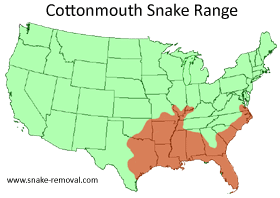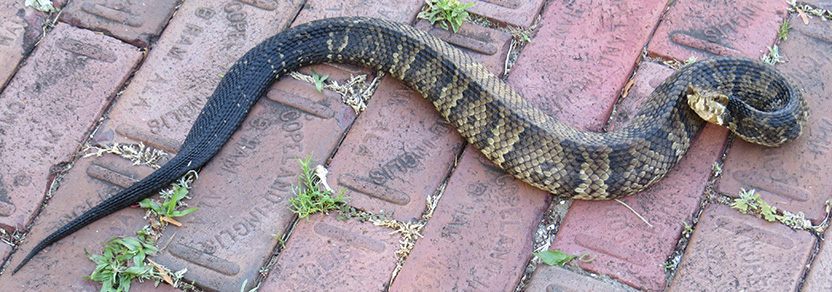
Cottonmouth
Appearance: Cottonmouth snakes, otherwise known as water moccasins,
are a medium sized snake, often growing to be four feet in length, and I've
even seen up to five feet. They
are generally a dark shade of brown or a dull black and will
occasionally have lighter banding visible on their sides. The younger snakes
have lighter color and more distinct patterns. Click here for
several more photographs,
including juvenile cottonmouths.
The body of this snake is considered to be bulky with a distinct neck going into a
relatively large, triangular head. The tail also tapers off quickly at the end of
the body, from fat to thin. Like most pit vipers, the cottonmouth has pupils
which are shaped like slits. This snake is considered very venomous,
producing a toxin which prohibits the ability of the blood to clot while
destroying tissue on a cellular level. Any area that comes in contact
with water moccasin venom will begin to hemorrhage, giving the name "cytotoxic" (similar to ‘hemotoxic’ )
to this type of poison.


Like all pit vipers, the cottonmouth snake has two heat sensing pits located between the eyes and the nostrils. These pits allow the snake to pinpoint live prey and to strike without the need of a visual. This hunting adaptation is particularly useful after dark when most animals’ bodies are warmer than the air around them. Hunting, and most of the snake’s activities, takes place during the night. Because of this, and because the water moccasin spends much of its time in the water, the snake spends a considerable amount of time basking in the sun. The cool water saps the snake’s body temperature much faster than land bound serpents. Basking is an efficient way to regulate body temperature.
Female snakes will give birth to litters of up to ten live snakes after the spring mating season. The babies are born from eggs which are hatched inside of the female snake and are not developed in a uterus like mammalian animals. Like almost all other reptiles, baby snakes are on their own as soon as they are born.
Cottonmouth diet: The cottonmouth eats a large variety of wildlife. Frogs, salamanders, fish, other snakes, birds, rabbits, squirrels, chipmunks, and a host of other small creatures are all fair game to the snake. When a prey animal is detected, the cottonmouth will strike, holding its victim for a moment to allow the full injection of venom to take place. Once that happens, the snake immediately releases its prey to limit the amount of retaliation, especially from strong mammals. If the prey escapes and runs away, the snake will track it by smell and consume it once it is dead.
Like the copperhead snake, young cottonmouths will use their tails to lure amphibians to them. Once the unsuspecting frog or salamander is close enough, the baby cottonmouth snake will strike. This method of attracting prey is called ‘caudal luring’.
Cottonmouth facts:
The cottonmouth snake gets its name from the defense position the snake takes when it feels threatened. When antagonized, the cottonmouth will coil up and display its fangs, revealing the pale white skin inside of the mouth.
Cottonmouths are very buoyant, with most of their bodies visible when they swim. Other, non-venomous water snakes will swim with their bodies completely submerged except for the head.
These snakes can and will attack underwater.
During the winter, cottonmouths will hibernate, sometimes sharing dens with other venomous snakes. In consistently warm climates, the cottonmouth has been known to not hibernate at all.
Commonly thought of as an aggressive snake, the cottonmouth’s reputation has been greatly exaggerated. If given the chance, the snake will flee before it will pose to strike.
The origins of the title ‘water moccasin’ are unknown, though it is speculated that name comes from the leather-like coloration of the snakes or the silent movement akin to that of moccasin wearing Native Americans.
Below are some other species of snake that may look like a XXX:
Copperhead Snake
Water Moccasin
Northern Water Snake
Brown Water Snake
Banded Water Snake
When do Cottonmouths give birth? Many people don't know: does the cottonmouth snake lay eggs or give birth to live young? The answer is that they give birth to live young! Usually about ten, but up to twenty, little baby cottonmouth snakes, each about ten inches long. That's how big baby cottonmouth snakes are at birth. Since they don't hatch from eggs, the mother snake is present when they are born, but they then abandon the young, despite some claims that they stick around to protect their offspring. When do they have the young? Usually in August or September. The young are also dangerous, so keep an eye out in late summer!
Why is a water moccasin called cotton mouth - The water moccosin snake, one of the deadly vipers of North America, has a secondary name, one that was given to it for identification purposes. Early settlers were warned of the water moccosin by Native Americans, the culture that is credited for giving the snake its original name. when travelers started fording rivers and deep streams, the danger of the water moccasin became very real. To spread the word in a more reliable manner, the name cotton mouth was given to the snake. This is because, when harassed, the snake will curl up and bare its fangs, exposing its pale, white mouth. The name cotton mouth was far easier to identify with danger than the poorly descriptive ‘water moccasin’. If you want to read more, check out Photographs of Water Moccasin. Both terms are still used today to refer to the water-loving serpent. Cotton mouths are often mistaken for common brown water snakes which are nonvenomous. There is no reason to handle a cotton mouth. If you see one sunning itself on the bank, leave it alone. More people are bitten by venomous snakes in an effort to kill them than are bitten from stumbling on the animal by accident. Vipers have the ability to strike with alarming speed and over substantial distance.
Many people want to know how to kill a Cottonmouth snake, but you don't need to. The best way to get rid of Cottonmouths is to simply leave them alone. You can also use a Cottonmouth trap to catch them - that's one of the best ways for how to remove Cottonmouth snakes. For more information, go to my Snake Removal - How to Get Rid of Snakes home page.